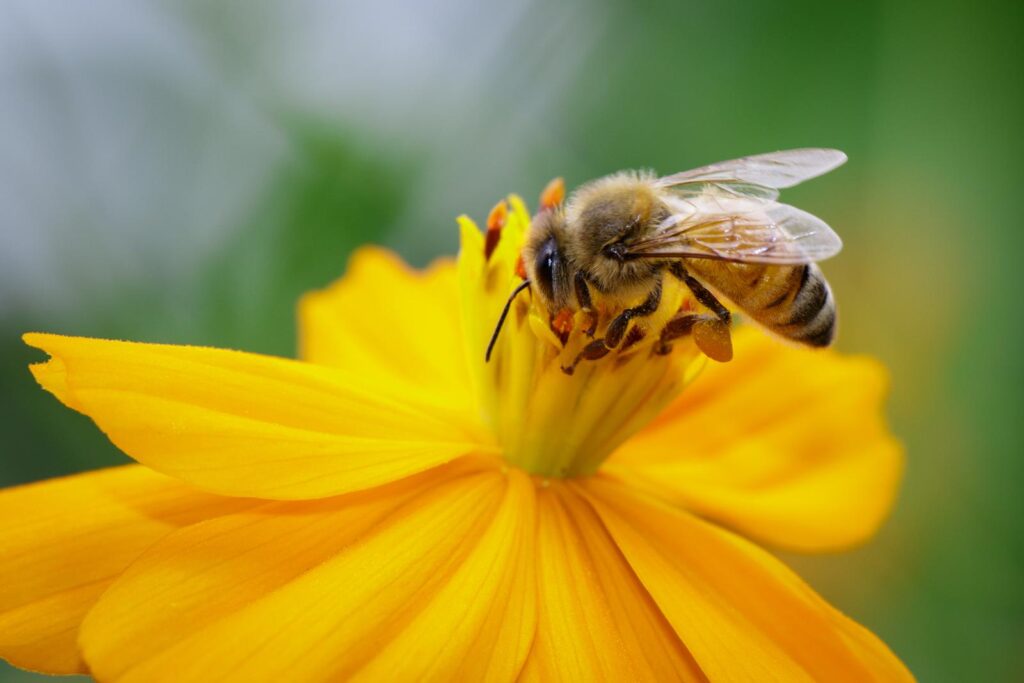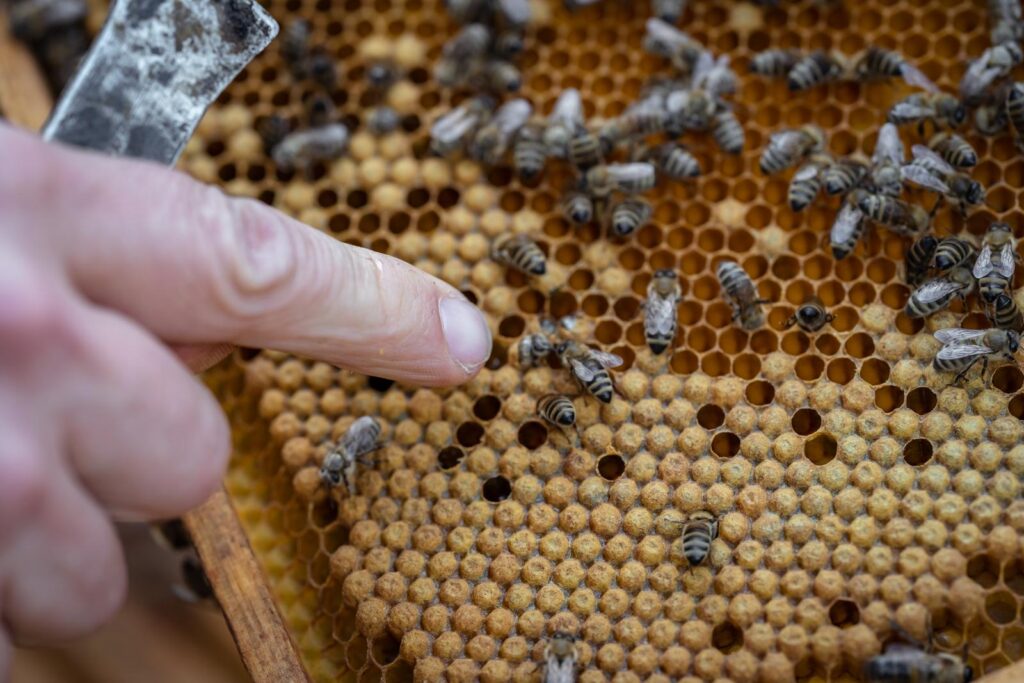We all know that honey is made by bees by collecting nectar and producing honey from it. Honey is also used for different purposes like eating and medicinal purposes, and we all thank the bees for it. It is an everlasting food source if sealed tightly, and we’ll look into the process of honey making. The article would explain the process of production of honey from nectar to the bottles in your grocery store.
From the flower:
The flower is the starting point of the production of honey, where the foraging honey bees collect the nectar. Depending upon specie to specie, flowers usually consist of floral nectaries, which are nectar-secreting glands. They may be found on different parts of the flowers, such as stamens, petals, and sepals but are more commonly found on the base of the flower. To get the nectar, the bees climb into the flower, and while doing so, many pollen grains stick to these bees which help in the pollination process.
In a single trip, the bees visit only a single species of a flower, and while it travels from one flower to another, pollination occurs or more precisely speaking, cross-pollination occurs. The honey collected by the bees is swallowed into the honey stomach and the bees return to their hives once it is full.
Once the bee is back in the hive, the process of trophallaxis occurs. Now, what is trophallaxis? It is the process in which the bee, when back to the hive, transfers all the nectar collected to the waiting worker. The transferred substance is not entirely nectar though, as it is mixed with enzymes, and a change is pH and chemical composition occurs in the honey stomach.
This substance is now suitable for long-term storage, and once transferred, the honey conversion process starts taking place.
The process inside the hive:
Moving on to the honey-making process now in the hive, the substance collected is now broken down into simpler substances and stored in the honeycombs. The bees constantly fan the honeycombs with their wings, which causes evaporation converting the nectar into honey. Comparing the two, where nectar is about 80% water, honey is only 18% hence the process is time taking. The honeycomb cells are then sealed with wax by the bees.
A bee colony is capable of producing about 60-120 pounds of honey a year and to produce a pound of honey, a bee must travel 55,000 miles. On average, only 1/12 of a teaspoon is produced by a single worker bee in its lifetime. Depending on the type and specie of the flower, the taste, color, and flavor of honey varies from hive to hive, hence the availability of honey varieties. For example, if we compare buckwheat honey and clover honey, buckwheat honey is darker in color while clover honey is light.
Harvesting and extraction of honey:
The beekeepers remove the excess honey as bees produce more honey than is required by their colonies. The honey is harvested by the beekeepers by the collection of honeycomb frames and the removal of the wax seal that was made by the bees for each cell.
The frames are placed in an extractor once the seal caps are removed and are then centrifuged in order to force out all the honey. It is spun, where gravity acts and pulls the honey to the bottom for collection. The extractors used can be manual or automated, a manual extractor can only hold a few frames while an automated one can hold several dozens of them at a single time.
Once extracted, the honey is then strained to get rid of any larger remaining particles, such as chunks of beeswax, pollen, propolis, or other particles. Some particles can still make it through the strainer, which only adds to the nutrient content and flavor. At times, the honey is even heated to a temperature where it won’t affect it composition, only to make the straining process easier and more effective.
The straining process is followed by the bottling process, where the honey is bottled, labeled, and dispatched to retailers, friends, or to your kitchen cupboard. The honey can be bottled either in a plastic bottle or a glass container depending upon the retailers but if the label says it’s raw honey, you don’t have to worry about anything and are good to go. This means that there have been no additives or preservatives added to the honey from the hive and to the bottle. If you’re still curious, you can check the label as well as the ingredients section for any details.
Natural and unprocessed honey:
Honey consists of high acidic content and low moisture which prevents the growth of any bacteria or harmful organisms. Hence, pasteurization is not done for that purpose but to slow down the granulation process. This means that the honey you buy would stay in its liquid state for more extended periods of time making it look appealing. However the pasteurization process also deprives the honey of many nutrient contents and pollen.
Some questionable resources also use corn syrup and other additives for mixing or entirely making fake honey to sell for cheaper prices. To avoid this, it is better to go for raw honey with all the beneficial constituents that is healthy for you.
The difference between processed honey and raw organic honey:
To educate you about the differences and what is best for you, we will list down some differences between processed honey and raw organic honey, which are as follows:
Processed honey:
- Has no pollen content.
- Consists of fructose corn syrup.
- Has a linkage to obesity, diabetes, liver damage, and hypertension.
- Narrows blood vessels and builds up plaque.
- It might contain antibiotics.
Raw organic honey:
- Consists of all nutrients, vitamins, and enzymes.
- Has antibacterial, anti-fungal, and antiviral properties.
- Helps in the stabilization of blood pressure and blood sugar levels.
- Boosts the immune system.
- Consists of powerful antioxidants.
- Promotes digestion.
- Helps in the healing of skin conditions.
Honey varieties:
Depending upon the origin, different hives can have different types and flavors of honey. Each of them can have a different flavor, different taste, consistency, and nutrient content. Some varieties of honey may have higher nutrient and antioxidant content than other varieties.
Different varieties are also used for different purposes, some are ideal for baking and cooking, and some are ideal for spreading over a nice and warm toast. Honey can also be used over salads, blended in teas, and is also ideally used for relief in cold. Some common varieties of honey are listed below:
- Acacia honey
- Buckwheat honey
- Alfalfa honey
- Wildflower honey
- Creamed honey
- Orange blossom honey
- Manuka honey
- Baker’s Special honey
Use of honey over history:
Honey has been used for long over the past for various purposes, including eatable, medicinal, and health purposes. Honey has anti-bacterial properties and high levels of antioxidants, which boost the immune system and help fight off various bacteria and foreign particles. Apart from that, honey is ideally used for colds and is often blended in warm lemon tea, which helps in relieving sore throat relieves nasal congestion, and acts faster in the treatment of cold and cough.
The Takeaway:
Honeybee works very hard in the production of honey and it is a long process from the nectar in flowers to the honey in the bottles that we find in grocery stores. All of these come in different varieties, which depend on the hive to hive and the origin, such as the flower species.
Honey that we buy may or may not be pasteurized, and we should look for raw honey as they contain all the nutrients and antioxidant properties compared to processed ones which can lose some of its nutrient contents during the pasteurization process. Honey has a long history of use and it is an ideal treatment for coughs and colds when mixed with warm tea.


